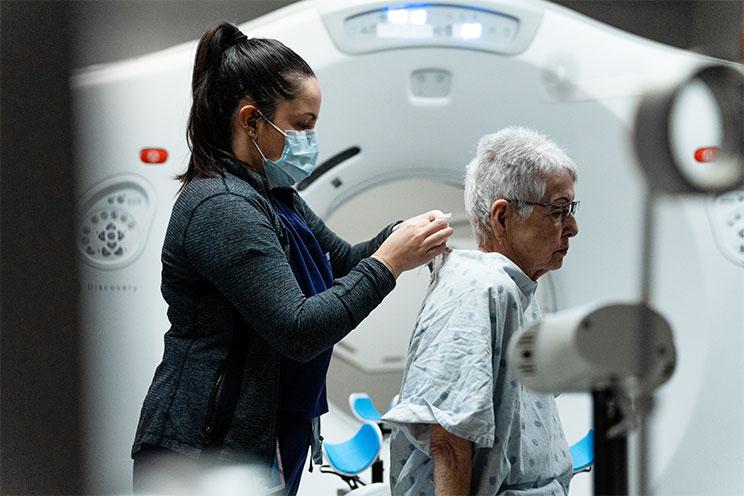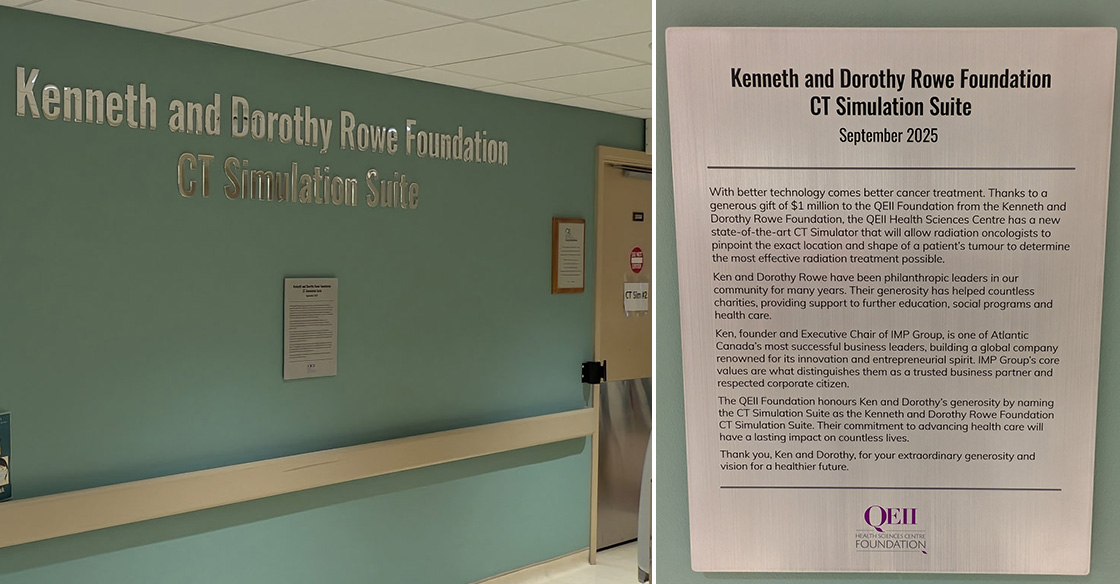
PHOTO CAPTION: Thanks to QEII Foundation donors, patients like Phyllis now have access to two new, advanced CT Simulators to scan more patients and fast-track the treatment process at the QEII’s cancer centre.
PHOTO CREDIT: Uncharted.Media
When someone in Nova Scotia learns they have cancer, there’s a good chance radiation therapy will become part of their care.
In fact, about 7,000 people receive a cancer diagnosis each year in this province, and about half require radiation. Before radiation treatment can begin, each patient must have a special scan in a CT Simulator.
Now, thanks to the generosity of donors, the QEII is home to two new CT Simulators to scan more patients and fast-track the treatment process.
All for the benefit of patients like Phyllis, who after having a unilateral mastectomy in 2020, was shocked to feel a lump in her chest wall in fall 2024.
Once the lump was removed from under the area of her first mastectomy, radiation was needed because there was no tissue remaining to remove should there be a reoccurrence. Phyllis also opted to have her second breast removed.
Phyllis had access to one of the new, advanced CT Simulators, thanks to donors who contributed $3.6 million to the QEII Foundation’s We Are campaign, including a lead $1-million gift from the Kenneth and Dorothy Rowe Foundation, to fund the technology at the QEII’s cancer centre.
What is a CT simulator?
Unlike CT scanners, which diagnose cancer, CT simulators capture patients’ bodies in the exact position doctors will place them in during treatment for their cancer. Detailed 3D images are taken by the CT simulator to help the care team create personalized radiation treatment plans.
The first new simulator was installed in the fall of 2024, and its twin followed weeks later; both went live in January 2025. In honour of the lead $1-million gift, patients are greeted and treated in the Kenneth and Dorothy Rowe Foundation CT Simulation Suite.
“We got both machines with all the bells and whistles … it allows us to obtain really high-quality images,” says QEII radiation therapist Adam MacDonald, who has spent nearly 20 years planning and delivering treatments. “It’s opened up some new special procedures that we wouldn’t have been able to do easily before.”
The scanners offer sharper image detail and the ability to capture hard to access areas through a larger field of view. The new technology will allow cancer care teams to better define the tumour and deliver higher doses of radiation, while sparing healthy tissue.

Smoother day for patients, staff
“I continue to be so impressed with the care and kindness from the QEII team. And I am so grateful to have had access to up-to-date technology,” shares Phyllis, who despite having gone through two cancer journeys, describes herself as lucky.
“The treatments are quick – just 15 minutes for me – and I only needed 15 treatments in total. I am so lucky to have the QEII right in my community. It really is a gem, and the staff are just so informative and kind.”
Every day, the added CT simulators help increase patient care two-fold.
“Now we’re routinely doing around 16 patients a day and we’ve had days where we’ve done 18 to 20 with the same number of therapists,” says Adam, noting with just one machine prior, the team used to cap the day at 10 to 12 patients.
With a typical CT simulator appointment lasting about an hour (30 minutes of education and preparation, followed by 30 minutes in the CT simulator room), the extra capacity is welcomed.
“If there’s an emergency that gets added on, we have room to add them to our roster for the day,” adds Adam. “Or if a machine needs preventative or unexpected maintenance, it doesn’t stop patient care.”
Donors as healthcare heroes
None of this would be possible without community generosity and the support of the QEII Foundation.
“Throughout the COVID-19 pandemic, we talked about healthcare heroes,” says Adam. “I think the donors should give themselves a little bit of credit too because in this act of giving, in no small part, they’ve become healthcare heroes. We’re proud of where we live and we’re proud of taking care of each other. We work hard as a community to ensure people can access not just basic care, but cutting-edge care in their home communities.”
Supporting the community and advancing health care are at the root of Kenneth and Dorothy Rowe’s giving. Ken is the founder and executive chair of IMP Group and is one of Atlantic Canada’s most successful business leaders, having built a global company renowned for its innovation and entrepreneurial spirit.
We are proud to support the QEII and the patients who will benefit from this technology,” says Ken Rowe, Executive Chairman of IMP Group. “We believe strongly in taking care of the health and safety of our employees and community members. The QEII provides crucial care to so many that it is a privilege to contribute to the vision of transforming lives.
Phyllis and her husband of almost 60 years are enjoying life, post radiation treatment — taking in some lake views and keeping up to date on the ongoings of their six grandchildren.